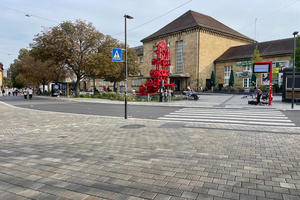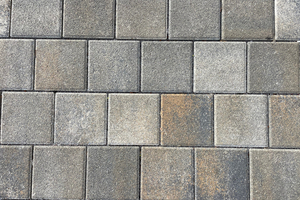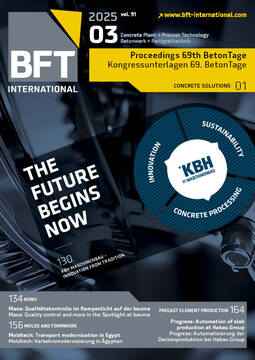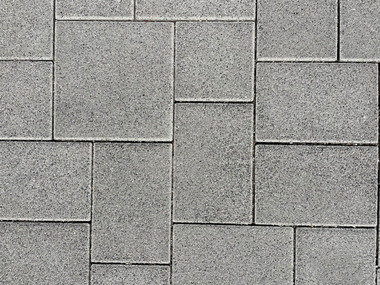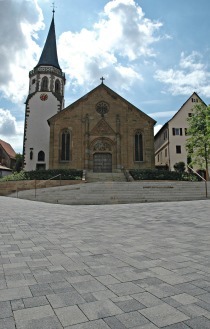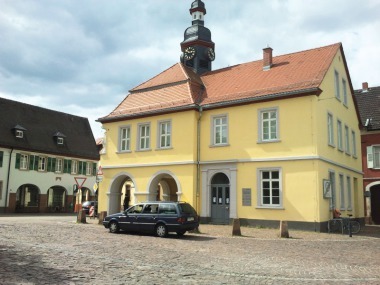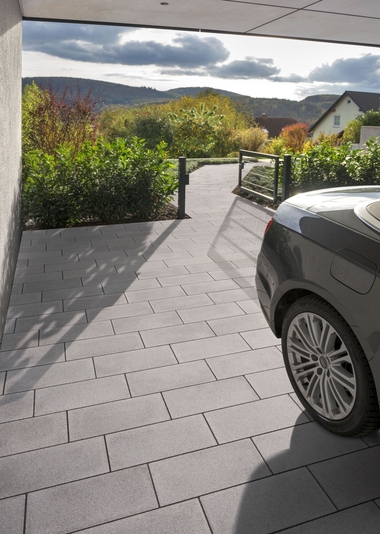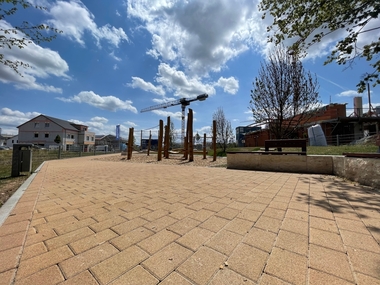Permeable concrete paver system for Bad Cannstatt railway station
The Bad Canstatt railway station is the second largest railway station of the Baden-Wuerttemberg capital city of Stuttgart after its main station. The station was a central starting point for the football fans during the European Football Championship 2024 on their way to the stadium and the entire NeckarPark venue. While the station square had been newly paved using a natural stone pavement of „Valser Quartzite“ right in time before the kick-off of this major event, the surrounding pedestrian paths were refurbished until the end of 2024 with a special permeable pavement.
So far, the station square was strongly characterized by its traffic function and split by the priority to the station building. Hence, for a long time, it did not satisfy the functional requirements of the high proportion of pedestrian and bicycle traffic. Therefore, the aim of the refurbishment was to relocate the vehicle traffic and to re-allocate the areas in favor of the environmental alliance and public space, moreover, to improve the climate and the quality of stay on the square substantially. Klaus Volkmer of the Department of Urban Planning at the Civil Engineering Office (Tiefbauamt) of the City of Stuttgart describes: „We made this possible by reorganizing the traffic. In future, we will refrain from the right of way to the station building, the pedestrian and bicycle traffic as well as public transport will be strengthened instead, with creating room for new recreational areas.“ A design of a uniform natural stone pavement made of „Valser Quartzite“ was chosen to strengthen the overall urban appearance of the square. However, aspects regarding climate adaptation also played an important role in redesigning the area surrounding the station. „We were able to preserve the entire stock of trees and to plant even more trees additionally. For an optimum distribution of water, stormwater tree trenches were installed between the tree planting sites. New beds were planted for draining the square, seeping surface water can get into the groundwater via the drain concrete base course that is installed below the pavement,“ states Volkmer.
Full-surface infiltration of paved areas
However, special standards did not only apply to the station square, but also to the newly designed and extended pedestrian paths. In this regard, Klaus Volkmer states: „Full-surface infiltration of paved areas plays a major role in Stuttgart‘s street planning. According to the principle of a sponge city, as much surface water as possible is to seep right on the spot, be directed to planting areas or is to be used for other purposes. The evaporation of the water shall also provide a cooling effect.“ For this reason, those responsible selected the Stuttgarter Sickerstein permeable block made by Betonwerk Adolf Blatt located in Kirchheim am Neckar for the surface area covering around 2,400 m². „The full-surface permeability and the fine-pored surface structure of the concrete block system in combination with the appealing color design were the decisive factors here,“ describes Klaus Volkmer. „In case of the Stuttgarter Sickerstein used here, the occurring precipitations are seeping through the block directly.“
The permeable blocks were installed here in the sizes of 30 x 20 and 20 x 20 cm, being 14 cm thick. As the block is produced of lightweight aggregate concrete with open structure, it complies with the water permeability specifications of at least 540 liters per second and hectare easily; moreover, this corresponds to twice the design rainfall and means that even in case of a stronger rainfall event, there will hardly be any surface run-off. Klaus Volkmer: „On the contrary, water is seeping into the base course layer underneath.“
Stuttgarter Sickerstein serves as „retention basin“ for stormwater
Due to the fact that the area paved with this paving system is able to absorb stormwater and to store it similar to a retention basin, considerable amounts of water evaporate right here before draining into the layers below or being discharged. „According to our experience, this works well even with the loess-loam soils that are only partially permeable to water and are commonly found in the Stuttgart region,“ explains Klaus Volkmer. „The evaporation leads to another positive effect: Where water is stored and is evaporating subsequently, surfaces do not heat up as fast when exposed to solar radiation as on conventionally paved areas or asphalt surfaces.“
However, the planners were also pleased with the visual appearance of the concrete block pavement. „With the mottled ocher-gray surface, the block pavement also matches the natural stone pavement of the station square very well,“ says Klaus Volkmer. „This creates harmony on the entire area, while providing a good contrast to the historically listed station building.“
CONTACT
Adolf Blatt GmbH + Co. KG Betonwerke
Am Neckar 1
74366 Kirchheim (Neckar)/Germany
+49 7143 8952-0

